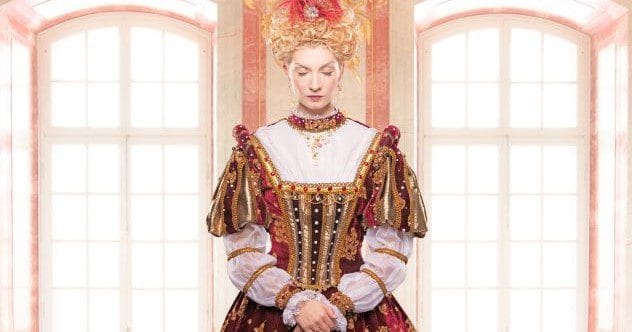Being a queen in England, or Great Britain, sounds like a dream. But for many, it was a life filled with immense pressure and deep sorrow. Whether they ruled in their own right or stood beside a king, these women faced unique challenges. One of the biggest pressures was producing an heir, a burden that brought untold suffering to many. This list explores the lives of queens who, despite their royal standing, endured heartbreaking losses, public scrutiny, and personal tragedies. Their stories remind us that even behind castle walls, human hearts can break.
10. Queen Anne
Queen Anne (1665–1714) was the first monarch of Great Britain. While royalty had its advantages, Anne’s life was marked by poor health and constant pregnancies. Imagine being pregnant 17 times! Tragically, out of 18 children (one pregnancy was twins), only one survived past infancy. A staggering 13 were miscarried or stillborn. It’s thought she might have had an immune disorder called antiphospholipid syndrome, which makes successful pregnancies very difficult.
Beyond these devastating losses, Anne battled severe gout. Adding to her sorrow, her beloved husband died five years into her reign. She was overcome with what was described as “unspeakable grief.” A few years later, Anne herself passed away after a series of strokes, ending the Stuart dynasty.
9. Margaret of Anjou
Margaret of Anjou (1430–1482) was queen consort of England twice. Married at just 15 to King Henry VI, her marriage wasn’t popular. In 1453, her husband suffered a mental breakdown, possibly catatonic schizophrenia, meaning a regent had to rule. Margaret tried to become regent but failed, leading to a fierce rivalry with her husband’s cousin, the Duke of York.
When Henry VI’s health improved, Margaret regained power. However, the War of the Roses soon erupted, and she found herself fighting desperately for her son Edward’s claim to the throne. Tragically, after years of struggle, her son was captured and killed. Like many queens on this list, she spent many of her later years imprisoned before being exiled to France, where she lived out her remaining days.
8. Anne Boleyn
Anne Boleyn’s (c. 1501–1536) story is well-known. As Henry VIII’s second wife, she played a key role in England’s break from the Catholic Church. Often remembered as a temptress, her life ended tragically with her execution. But Anne was an enthusiastic queen, eager to help shape the new Church of England. Sadly, Henry VIII’s main concern was whether she could give him a son.
After giving birth to her daughter Elizabeth and suffering two miscarriages, the pressure on Anne was immense. In 1536, things fell apart quickly. She was accused of adultery and even incest. Henry had lost interest and was already falling for his next wife, Jane Seymour. With no real evidence, Anne was sentenced to death. She spent her final weeks desperately trying to save her position, or at least her life, but ultimately faced a tragic end.
7. Charlotte of Mecklenburg-Strelitz
Queen Charlotte (1744–1818), a German princess, married King George III without knowing a word of English. She learned quickly, and they had fifteen children. For 25 years, they enjoyed a happy life together. However, George III’s mental health declined, leading to his infamous “madness.”
The King’s unpredictable and sometimes violent behavior terrified Charlotte. She gradually distanced herself from him until they lived entirely separate lives. She essentially lost her partner to his illness. Though she grieved the loss of her happy marriage, Charlotte eventually found comfort and fulfillment in science, literature, and particularly botany.
6. Henrietta Maria of France
Henrietta Maria (1609–1669) became queen when she married Charles I. As a Catholic in Protestant-ruled England, she faced constant criticism. Her husband, Charles I, was eventually executed. In the years leading up to this, Henrietta Maria endured increasing public disapproval for their decisions, even for the beautiful chapel she had built for herself.
She struggled with a poor public image, and it seemed there was little she could do right in the eyes of the people. When Charles was executed in 1649, she began to wear only black and spent the rest of her life quietly, away from the public eye.
5. Eleanor of Aquitaine
Eleanor of Aquitaine (1122–1204) was queen of both France and England during her lifetime. As Queen of France, she faced hardships with her husband during the Crusades, and the stress eventually led to their separation. Their marriage was annulled. Eleanor inherited a large estate, making her a very desirable match, and she faced risks of being kidnapped into another marriage. Though she wished to remain single, she soon married an English prince, who later became Henry II of England.
The royal couple had eight children, but Eleanor was often frustrated by Henry’s lack of interest in them. When one of her sons tried to overthrow the king, Eleanor supported him. Unfortunately, the plot failed, and she was imprisoned for sixteen years. She only regained her freedom after her husband’s death. Amazingly, she is remembered as a strong and capable regent for her son while he was away fighting in the Crusades.
4. Catherine Howard
Yes, another of Henry VIII’s wives makes this list, and it’s hardly surprising. When Catherine Howard (c. 1523–1542) married Henry, he was nearly 50, and she was barely 18. With such a large age gap and Henry’s declining health, it wasn’t a romantic match. Though he openly expressed his attraction to her, Catherine had little freedom and eventually sought attention from younger men.
Her affairs were widely discussed, leading to her downfall. Was she to blame for seeking companionship, or was she unfairly judged? A letter to her lover, Thomas Culpepper, is often seen as proof of her adultery. However, some suggest she was merely trying to fend off his advances with kind words. Henry initially refused to believe the accusations due to his affection for her, but more allegations surfaced. After confessing to several encounters, Catherine was executed in 1542.
3. Matilda of Flanders
Matilda of Flanders (d. 1083) was the wife of William the Conqueror and England’s first queen consort. Before becoming queen, when William, then Duke of Normandy, proposed from afar, she boldly refused, stating she wouldn’t marry a man of illegitimate birth.
Upon hearing her refusal, William rode tirelessly to her. When he found Matilda, he reportedly grabbed her by her hair, threw her to the ground, and beat her. He then left immediately. After recovering, Matilda surprisingly announced she would marry no one but William. This shocking start perhaps hinted at the nature of their future relationship.
2. Elizabeth Woodville
Elizabeth Woodville (1437–1492) followed Margaret of Anjou as queen consort. Not of noble birth, she was unpopular, especially for favoring her relatives. She was the mother of the famous “Princes in the Tower,” who vanished shortly after being placed in the care of Richard III.
It’s unknown how Elizabeth truly felt about their disappearance, but she undoubtedly suffered as her husband’s heirs were systematically removed. Later, when Henry VII took the throne, Elizabeth was suspected of being involved in a plot to overthrow him. Without much investigation, she was sent to a nunnery, where she spent the rest of her life in isolation, dying quietly after several years.
1. Queen Mary I
Queen Mary I (1516–1558), often known as “Bloody Mary,” might not seem like someone who suffered. She ordered the brutal execution of many Protestants, yet she herself endured hardship for her Catholic faith. Her father, Henry VIII, declared her illegitimate early in her life. Nearing her brother’s death, she was removed from the line of succession, though she was meant to be his heir.
Mary began life as a respected princess but was later forgotten and neglected due to the ambitions of the men around her. After ascending the throne in 1553, she knew a Catholic heir was crucial to keep England Catholic, so she married the King of Spain. However, Mary found herself largely ignored; Philip II rarely visited, and she was never able to have a child.
So desperate was Mary for an heir that she experienced two false pregnancies, one lasting over a year. She undoubtedly faced extreme stress and public ridicule for this “delusion” of being pregnant. She spent over three months confined, awaiting a birth that never came, emerging to face immense disappointment from both the public and herself.
The lives of these queens show that royal status did not shield them from profound personal suffering. From lost children and unfaithful husbands to political turmoil and public scorn, their stories are a poignant reminder of the human cost of power and the resilience of an individual spirit.
Which queen’s story do you find the most moving? Share your thoughts in the comments below!










